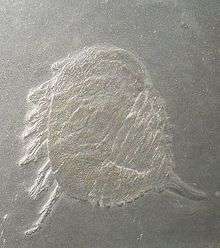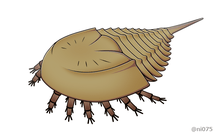Weinbergina
Weinbergina is a genus of synziphosurine,[1][2] a paraphyletic group of fossil chelicerate arthropods.[3][4] Weinbergina was regarded as part of the clade Prosomapoda.[5][6][7][4][8] Fossils of the single and type species, W. opitzi, have been discovered in deposits of the Devonian period in the Hunsrück Slate, Germany.[2] With Weinbergina as type genus, Weinbergina, Legrandella and Willwerathia were once united under the single family Weinberginidae,[2] an interpretation which is not recovered by later phylogenetic analysis.[5][6][7]
| Weinbergina | |
|---|---|
 | |
| Fossil of W. opitzi, Naturmuseum Senckenberg | |
| Scientific classification | |
| Kingdom: | Animalia |
| Phylum: | Arthropoda |
| Subphylum: | Chelicerata |
| Clade: | Euchelicerata |
| Clade: | Prosomapoda |
| Genus: | †Weinbergina Richter & Richter, 1929 |
| Type species | |
| †Weinbergina opitzi Richter & Richter, 1929 | |

Weinbergina is unusual in having 6 pairs of walking legs instead of 5 or less like those of other euchelicerates.[2][9] The additional 6th leg pair was regarded to be originated from somite 7, thus homologous with the chilaria of horseshoe crab and 4th walking legs of sea spider.[2][3][9] However, the twelve-legged interpretation is not universally accepted - for example, Weinbergina was originally described as ten-legged like extant horseshoe crab;[2] Selden, Lamsdell & Qi, 2015 noted that the structures previously identified as distal regions of walking legs may be in fact leg-like exopods like those of Offacolus and Dibasterium.[5]
References
- Stürmer, Wilhelm; Bergström, Jan (1981). "Weinbergina, a xiphosuran arthropod from the devonian hunsrück slate" (PDF). Paläontologische Zeitschrift (in German). 55 (3): 237–255. doi:10.1007/BF02988142. ISSN 1236-9874 Check
|issn=value (help). - Moore, Rachel A.; Briggs, Derek E. G.; Bartels, Christoph. "A new specimen of Weinbergina opitzi (Chelicerata: Xiphosura) from the Lower Devonian Hunsriick Slate, Germany". Paläontologische Zeitschrift. 79 (3): 399–408. ISSN 0031-0220.
- Lamsdell, James C. (2013). "Revised systematics of Palaeozoic 'horseshoe crabs' and the myth of monophyletic Xiphosura". Zoological Journal of the Linnean Society. 167 (1): 1–27. doi:10.1111/j.1096-3642.2012.00874.x. ISSN 0024-4082.
- Bicknell, Russell D. C.; Pates, Stephen (2020). "Pictorial Atlas of Fossil and Extant Horseshoe Crabs, With Focus on Xiphosurida". Frontiers in Earth Science. 8. doi:10.3389/feart.2020.00098. ISSN 2296-6463.
- Selden, Paul A.; Lamsdell, James C.; Qi, Liu. "An unusual euchelicerate linking horseshoe crabs and eurypterids, from the Lower Devonian (Lochkovian) of Yunnan, China". Zoologica Scripta. 44 (6): n/a–n/a. ISSN 0300-3256.
- Lamsdell, James C.; Briggs, Derek E. G.; Liu, Huaibao P.; Witzke, Brian J.; McKay, Robert M. (2015). "A new Ordovician arthropod from the Winneshiek Lagerstätte of Iowa (USA) reveals the ground plan of eurypterids and chasmataspidids". The Science of Nature. 102 (9–10): 63. doi:10.1007/s00114-015-1312-5. ISSN 0028-1042.
- Bicknell, Russell D. C.; Lustri, Lorenzo; Brougham, Tom (2019-12-01). "Revision of "Bellinurus" carteri (Chelicerata: Xiphosura) from the Late Devonian of Pennsylvania, USA". Comptes Rendus Palevol. 18 (8): 967–976. doi:10.1016/j.crpv.2019.08.002. ISSN 1631-0683.
- Dunlop, J. A.; Penney, D.; Jekel, D. (2020). "A summary list of fossil spiders and their relatives" (PDF). World Spider Catalog. Natural History Museum Bern. pp. 1–296.
- Dunlop, Jason A.; Lamsdell, James C. (2017-05-01). "Segmentation and tagmosis in Chelicerata". Arthropod Structure & Development. Evolution of Segmentation. 46 (3): 395–418. doi:10.1016/j.asd.2016.05.002. ISSN 1467-8039.